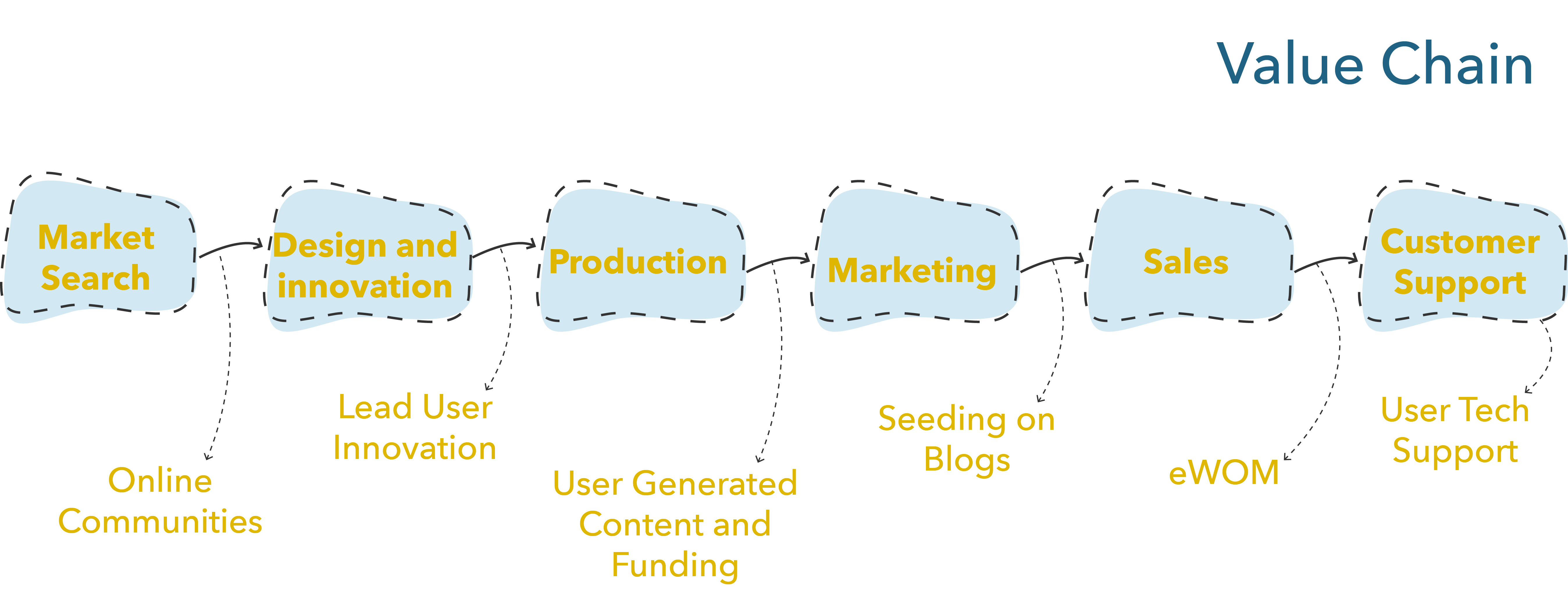Engaging Customers in Co-Creation Activities
Co-creation refers to the joint creation of value by a company and its customers (Prahalad and Ramaswany 2004). Nowadays, most marketing activities can be co-created with consumers, whether those activities be market research, product innovation, advertising campaigns, or customer support.
We can categorize consumers into two broad categories of co-creators. The first category is composed of user innovators or lead users, highly involved and highly competent consumers who participate in co-creation activities to answer their own needs or desires. This is the kind of co-creator that MIT professor Eric Von Hippel has been studying since the mid-1980s. Lead users have been found to co-create value with firms in diverse markets, such as 3M and surgeons in the medical industry, amateur and professional athletes in sports as varied as windsurfing, rollerblading, snowboarding, and rodeo kayaking (e.g., Shah 2003), or computer geeks and open source software in IT (Von Hippel 2005).
The second category of co-creators is everyday consumers. These co-creators are people who are not particularly involved in a product category or particularly competent. They will probably not benefit from their co-creation activities. They participate in co-creation activities because it serves their needs (e.g., taking on the role of a clerk when using an ATM or self-checkout), because it is part of their activities with a company (e.g., co-creating content when we post social media content), or because it is fun (e.g., participating in a contest where we can choose the name of a product or redesign an ad).
A useful tool for thinking about how consumers can participate in co-creation activities is the value chain. The value chain is a tool that helps conceptualize where value is created in firm activities. For example, the marketing function can be thought of as the set of activities shown in Figure 9.2 (text version here), through which a firm creates value for itself and its customers.
Figure 9.2 Value Chain

Each of these activities can create value. For example, market research creates value by leading to a better understanding of consumers and their needs. Innovation helps create products that address those needs. Production creates value by turning a concept into reality. Marketing creates value by attracting sales and customers, and sales create value by making these sales happen and distributing products to consumers. Customer support creates value by maximizing retention and satisfaction.
The value chain helps us understand how to co-create value with consumers by emphasizing where they can create value. Let’s see how value can be co-created during each of these activities.
For market research, one of the most obvious ways that consumers co-create value is by sharing their opinions with firms. For some companies, this mechanism has been formalized outside of ad hoc research efforts. For example, DeWalt set up an “Insight Community,” which they use to send several surveys per week to interact with consumers. By using this community rather than traditional market research firms, they estimate they saved about $5 million in market research costs in 2016 alone. Another example of value co-creation in market research is crowdsourced market research firms such as Trendwatching. Trendwatching publishes regular reports on emerging trends in different markets. To create these reports, they rely on an international community of trend watchers that are part of its TrendWatching Global Insight Network (tw:in) who are tasked with spotting emerging trends and sharing them with the company.
For design and innovation, there are many examples of companies who have tasked consumers with coming up with innovative ideas. Examples include initiatives where everyday consumers discuss new product ideas with firms, such as Lego Ideas and BMW Co-Creation Lab. Other initiatives pitch lead users in competition against one another, such as the Heineken Open Design and the Anheuser-Busch “King of Beers.”
At the production stage, examples vary. In our everyday lives, we all contribute to co-producing social media content, which we then consume from one another. Social media is mostly a co-created activity. Although we all follow celebrities with audiences of varying sizes, content producers are often other consumers like you and me. The business model of social media firms aims to provide a platform for co-creation (and monetize this platform with ads), but users are those who produce what is consumed. For material products, there is some hope that the rise of 3D printing will lead to consumers being able to co-produce products at home. Even today, designs can be downloaded online, and consumers are responsible for manufacturing the product at home. This echoes other “maker” activities, such as sewing or knitting, where making something is the consumption activity (e.g., making a shirt from a pattern). Product customization, such as NikeID, is also an example of the co-production of products since consumers are tasked with making design decisions.
For marketing, any marketing campaign based on word of mouth, such as viral marketing, is a co-created marketing activity. In such campaigns, consumers become co-creators of the campaign by participating in its diffusion. Shareable content, such as Spotify yearly “Wrapped” or more traditional entertaining advertisements such as Dietz & Watson Dietz Nuts recruit consumers who become channels through which ads are diffused. In other campaigns, such as hashtag campaigns, consumers’ role as co-creator is heightened as they also co-produce content.
Similarly, sales can co-created by consumers when they share product links or promo codes or when they contribute to companies’ sales pitches by writing testimonials or positive reviews.
Lastly, consumers regularly co-create customer support. Forums where consumers answer each other questions, such as Apple Support Communities or Tesla Forums, co-create customer support. Consumers similarly answer one another’s questions in different ways, such as in communities not directly owned by brands. They also create content on blogs and social media channels such as YouTube to explain how they address some issues they might have faced.

No Comments